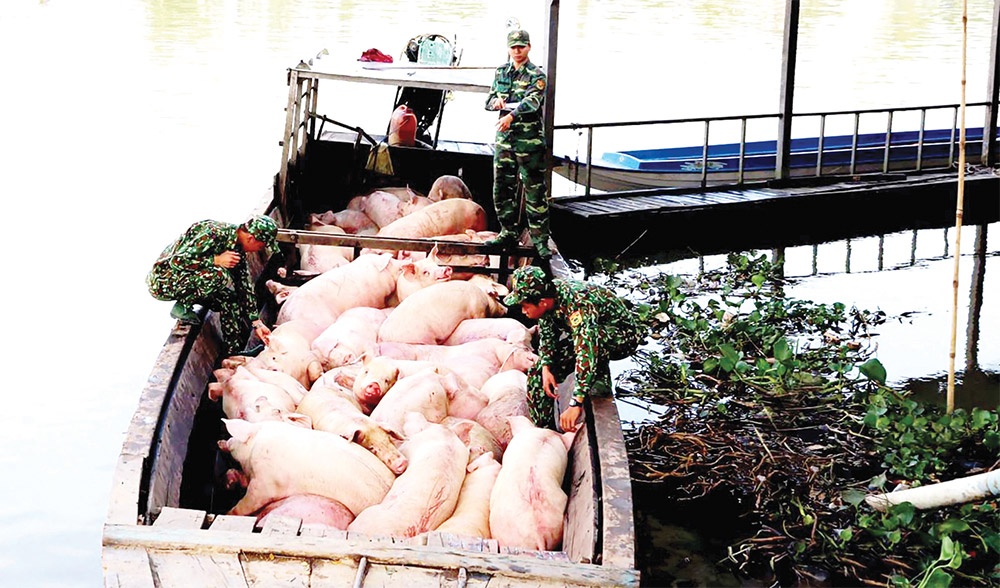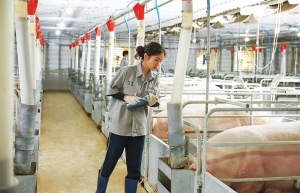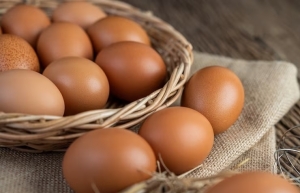Smuggling continues to harm livestock gain
 |
| Some Vietnamese localities are being urged to investigate the smuggled pig trade, photo Le Toan |
In the lead up to Lunar New Year, both demand and prices are rising, and so is the volume of smuggled pigs, according to Nguyen Tri Cong, chairman of the Dong Nai Livestock Association in the southern province of Dong Nai.
“We have sent an express document to the prime minister on preventing, detecting, and strictly handling cases of illegal trading and transportation of pigs across the border into Vietnam because this is a problem,” Cong said. “It is no longer limited to one province, but is a nationwide and very urgent problem. The association knows what has to be done, so it made recommendations to protect livestock farmers in Dong Nai and in the rest of the country.”
During the two first weeks of January, as many as 7,000 pigs on average are smuggled into Vietnam every night from Cambodia through a number of border gates. He said that the number of smuggled pigs accounts for about 30 per cent of domestic livestock output sold every day.
In the north-central region, informally imported pigs from China and Thailand through Quang Binh and Quang Tri border gates cost around $2.20 per kg. In the southern region, thousands of Thai pigs per day are seemingly smuggled through the Long An border gate at a price of about $2.10 per kg.
Le Thanh Phuong, from a foreign-invested livestock enterprise in the southern province of Binh Duong, explained that livestock farms in Cambodia have developed strongly in recent years, and the cost of live pig breeding is only about $1.50 per kg.
“In China, pig breeding is a profitable job, so numerous farms have been built over the last three years. The selling price is nearly $2 per kg of live hogs in China and in Thailand, and $2.20 in Laos. The selling price differences are significant enough that traders can earn a good profit margin by transporting live pigs across the border,” Phuong said.
In 2023, most livestock enterprises suffered losses because of reduced purchasing power, while animal feed prices have not dipped. Even in times of normal and peaceful farming, the current selling price of live pigs is only equal to the production cost, Phuong added.
Cong from the Dong Nai Livestock Association highlighted that if smuggled pigs are not controlled, there will be a risk of disease spreading. “In addition, smuggled pigs are difficult to control in terms of quality, which will affect consumers. In the future, competition from smuggled pigs will seriously affect the total pig herd, causing a shortage of domestic supply,” Cong emphasised.
During recent years, the domestic livestock industry has been under a lot of pressure from epidemics. Production below cost has forced losses, and many farms and livestock households had to reduce herds or stop production.
“The problem now is the price. For a long time, farmers had to sell pigs below production costs. Specifically, the cost of raising pigs has historically been about $2.30 per kg, but for a long time, it has only fluctuated at $2-2.10 per kg of live pigs. Thus, by raising a pig, farmers are facing a loss of $23-30 for each one,” Cong said.
“In the current situation, continuous production below cost and low purchasing power combined with smuggled pigs will drag down the livestock industry very quickly,” he insisted.
Deputy Minister of Agriculture and Rural Development Phung Duc Tien said that domestic pig prices are higher than in some surrounding countries.
“The ministry has received feedback from numerous businesses and directed the Ministry of Agriculture and Rural Development’s (MARD) Department of Animal Health to carry out inspections in some localities. We have also found two facilities collecting a large number of pigs in the border area of Long An province,” Tien said.
“However, due to a poor professional force and facilities like these carrying out various tricks, the veterinary agency could not inspect the transport of pigs inland. Authorities have asked Long An province to seriously investigate smuggled pig transportation and trade,” he added.
According to the MARD’s Department of Livestock Production, in December 2023, the import value of official livestock products reached $330 million, raising the total import value of such products for the whole of 2023 to $3.53 billion.
 | Livestock companies latch onto gains involving circular economic model The circular economy is hitting its stride among livestock companies across the country, and are expected to gain increased revenues in the next few years thanks to applying fresh and greener methods. |
 | Nation looks abroad for livestock boon Agricultural businesses and state management authorities are accelerating negotiations with global partners to unlock export markets, helping Vietnam to target of $1.5 billion of livestock products exports in 2025. |
What the stars mean:
★ Poor ★ ★ Promising ★★★ Good ★★★★ Very good ★★★★★ Exceptional
 Tag:
Tag:
Related Contents
Latest News
More News
- Double-digit GDP growth within reach with shift to higher-value expansion (January 06, 2026 | 08:33)
- Takeda Vietnam awarded for ongoing support of Vietnam’s sustainability efforts (December 31, 2025 | 21:00)
- Vietnam's retail market tops $269 billion in 2025 amid e-commerce boom (December 31, 2025 | 19:00)
- Stronger legal framework urged as trade fraud surges online (December 31, 2025 | 18:58)
- FPT exports first chip shipment to Japan (December 31, 2025 | 10:47)
- AkzoNobel rolls out sustainability campaign “It All Adds Up” for the wood sector (December 31, 2025 | 09:23)
- Textile apparel firms deliver robust earnings despite global tariff pressures (December 30, 2025 | 10:09)
- Businesses ramp up production as year-end orders surge (December 30, 2025 | 10:05)
- Vietjet chairwoman awarded Labour Hero title (December 29, 2025 | 13:06)
- How to unlock ESG value through green innovation (December 29, 2025 | 10:03)



















 Mobile Version
Mobile Version